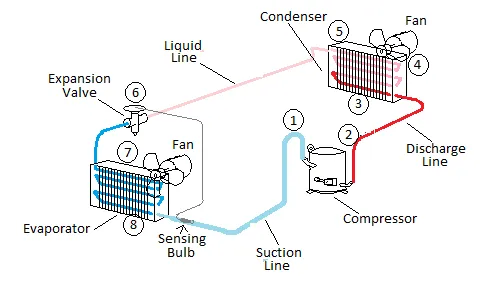
If you’re interested in developing a product with cooling or refrigeration features, it may be helpful to understand how refrigeration works. Refrigeration is used by refrigerators and air conditioning systems alike and is the most effective way to control hot temperatures in any engineering application.
The refrigeration cycle is a system that takes advantage of unique chemical properties of fluids known as refrigerants. By using the relationship of pressure and temperature, an air conditioning system is able to cool refrigerant which can then be used to cool air.
An air conditioning system is made up of six parts: a cooling coil, a condenser coil, a compressor, an evaporator fan, a condenser fan, and an expansion valve. All of these parts work together to increase or decrease the pressure, and thereby the temperature, of refrigerant.
The refrigerant moves through and interacts with these components in a 4-step cycle:
The refrigeration cycle begins with refrigerant as a warm liquid which is introduced into a compressor. The compressor pressurizes the refrigerant until it becomes a hot gas.
From there, the hot gas refrigerant travels through a condenser coil which is exposed to ambient air, often outdoors. A fan in the condenser forces air over the condenser coil to disperse heat from the hot gas refrigerant until it condenses and becomes a hot liquid.
The hot liquid refrigerant passes through an expansion valve which reduces the refrigerant pressure until it becomes a very cold liquid.
The cold liquid refrigerant moves through a cooling coil where the evaporator fan forces warm air from the space being cooled over the cooling coil. Heat from the air is transferred to the cold liquid refrigerant until the air becomes cold enough to cool the space. It also raises the refrigerant temperature until it becomes a warm liquid where the cycle begins anew.

A diagram of a refrigeration cycle.
Most cooling systems are so-called “split systems” which are made up of an air handler and a condensing unit. The air handler is where the cooling coil and evaporator fan are located. The condenser coil, compressor, condenser fan, and expansion valve are all located in the condensing unit. There are some systems, called packaged systems, which house all of the components within a single piece of equipment.
For large cooling needs, it is often best to locate the condenser section of the cooling system outdoors. This is because the condenser will give off large quantities of heat which, if indoors, will often require additional cooling systems to accommodate. For small appliances, basic electronics, or where little cooling is required, the condenser can be located indoors.
No matter what type of equipment is used, you can bet that the basic cooling function of your air conditioning system or product uses the simple refrigeration cycle described above.